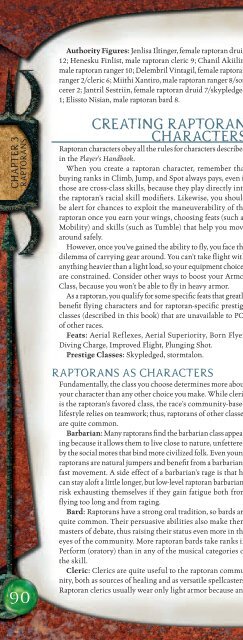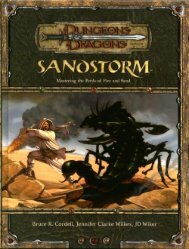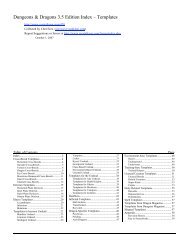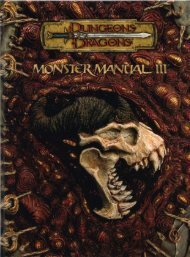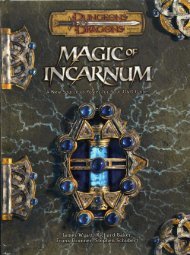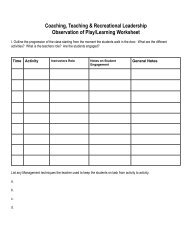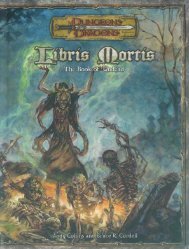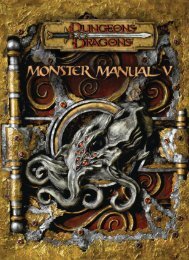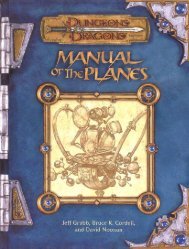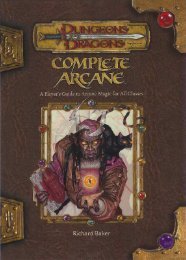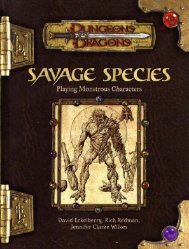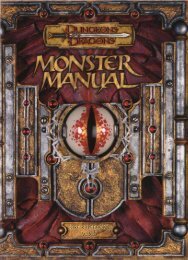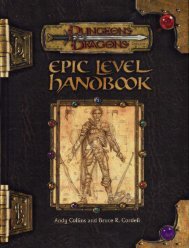CHAPTER 8CAMPAIGNS INTHE WILD178THE SETTINGA campaign focusing on one <strong>of</strong> the races covered in thisbook is likely to feature wilderness locales far away fromcities. Adventures will take place in secluded valleys, amongtrackless forests, and along long, lonely roads. Urban andunderground adventures might prove rare. This sort <strong>of</strong>campaign will impact play in several ways.Regional Scope: The action in the campaign probablywill focus on an entire region rather than on one settlementor dungeon. Characters will make long overland treksfairly <strong>of</strong>ten as they pursue adventures in widely separatedlocales. Most <strong>of</strong> their best friends and worst enemies willbe far away from wherever the group happens to be at anygiven time.Slower Pace: Encounters may occur several days apartwhen the PCs make a long wilderness trek, allowing themample time to recover their strength between challenges.Individual encounters can be tougher (and <strong>of</strong>ten should be)because the PCs can start them with full hit points and fullcomplements <strong>of</strong> spells and class features.On the other hand, it could be days or weeks before theycan replenish their supplies. Groups that run out <strong>of</strong> potions,scrolls, alchemist’s fire, silvered arrows, or other exhaustiblesupplies may find otherwise easy challenges more difficultthan usual. A long adventure undertaken with inadequatesupplies can be a real struggle for groups that don’t planadequately. Even groups gifted with good foresight mighttake days or weeks to complete simple tasks. The DM mustset the pace <strong>of</strong> events accordingly (at least until the partygains access to teleportation magic or some other means <strong>of</strong>rapid travel).Sprawling Encounters: Most encounters will take placeoutdoors. Indoor and underground encounters are confinedwithin the bounds <strong>of</strong> chambers and halls, and fighting takesplace at close range, with little time or room for maneuveringbefore the two sides close to melee.Outdoors, however, encounters can take place at distanceslimited only by the extent <strong>of</strong> vision, which can be considerableindeed. Ranged combat is common, and both sidesusually have ample time and space to maneuver and use theterrain to advantage.DEMOGRAPHICSChapter 5 <strong>of</strong> the Dungeon Master’s Guide provides guidelinesfor randomly generating communities <strong>of</strong> various sizes.However, the communities described there are designedto mirror average communities throughout a campaignworld and therefore favor humans as the most numerousmembers <strong>of</strong> any community. To create racial communitiesthat feel different from human communities, use thefollowing guidelines.ELF COMMUNITIESElves rarely form big communities. They crave open spacesand try to minimize their impact on the land. As such, elfcommunities are generally smaller and farther apart thanhuman communities. Such communities also usually havea nearly homogenous population. The exceptions are majorpolitical, religious, or scholastic centers—places that cannotfunction well without a large number <strong>of</strong> people.Elf communities have the normal gold piece limit forpurchases. However, the gold piece limit when purchasingspecial items <strong>of</strong> elven manufacture (such as elven harps andcloaks <strong>of</strong> elvenkind) is 50% higher than the indicated value.The same increase applies for items that elves use <strong>of</strong>ten(both magical and mundane), including projectile weapons,ammunition, light armor, scrolls, and potions.Elf communities use the general guidelines for determiningpower centers, power center alignment, and highest-levellocals given in Chapter 5 <strong>of</strong> the Dungeon Master’s Guide, exceptas noted here.Table 8–1: Random Elf Community Generationd% Community Size Population 1 GP Limit 201–15 Camp 20–80 40 gp16–30 Outpost 81-400 100 gp31–50 Village 401–900 200 gp51–70 Small town 901–2,000 800 gp71–90 Large town 2,001–5,000 3,000 gp91–95 Small city 5,001–12,000 15,000 gp96–99 Large city 12,001–25,000 40,000 gp100 Metropolis 25,001 or more 100,000 gp1 Adult population. The number <strong>of</strong> nonadults in anelf community ranges from 1% to 10% <strong>of</strong> the adultpopulation.2 Add 50% for projectile weapons, ammunition, lightarmor, scrolls, potions, and special items <strong>of</strong> elven make.Table 8–2: Racial Mix <strong>of</strong> Elf CommunitiesIsolated 1 Mixed 1 Integrated 198% elf 90% elf 60% elf1% halfling 2 6% halfling 2 20% halfling 21% other races 3% gnome 3 15% gnome 31% other races 5% other races1 Typically 85% <strong>of</strong> elf communities are isolated, 14% aremixed, and 1% are integrated.2 Most <strong>of</strong>ten tallfellows.3 Most <strong>of</strong>ten forest gnomes.HALFLING COMMUNITIESHalfling communities are generally smaller and farther apartthan communities <strong>of</strong> other races.Halfling communities use the general guidelines fordetermining power centers, power center alignment, andhighest-level locals given in Chapter 5 <strong>of</strong> the DungeonMaster’s Guide.Permanent halfling communities usually have a mercantilebase; the gold piece limit for purchasing items is doubled insuch communities.
Table 8–3: Random Halfling Community Generationd% Community Size Population 1 GP Limit 201–20 Thorp 3 20–80 40 gp21–40 Hamlet 81-400 100 gp41–60 Village 401–900 200 gp61–80 Small town 901–2,000 800 gp81–95 Large town 2,001–5,000 3,000 gp96–100 Small city 5,001–12,000 15,000 gp— 4 Large city 12,001–25,000 40,000 gp— 4 Metropolis 25,001 or more 100,000 gp1 Adult population. The number <strong>of</strong> nonadults in ahalfling community ranges from 25% to 30% <strong>of</strong> the adultpopulation.2 In a permanent community (not a caravan), use twicethis value when setting the maximum value <strong>of</strong> itemsavailable for sale.3 Most caravans use these values when on the move.4 Halfling large cities and metropolises exist only wherethe DM chooses and are never generated randomly.Elf communities usually get along without a visible policeforce, but unseen sentries are on hand to quell trouble. Elvesare tolerant, but they can afford to be because they don’t tendto disrupt other lives.Because so many elves work magic, elf communities tendto have magical power centers. (The chance for an elf communityto have a magical power center is considerably higherthan suggested on the Power Centers table on page 137 <strong>of</strong> theDungeon Master’s Guide.)Elf communities also tend toward chaotic power centersmost <strong>of</strong> the time, with chaotic good being most common(see Table 8–6). Lawful elf settlements usually have someconnection with Vandria Gilmadrith (clerics <strong>of</strong> Vandriamay hold power, or key citizens may be her worshipers).Likewise, evil settlements <strong>of</strong>ten have some connectionwith Lolth.CHAPTER 8CAMPAIGNS INTHE WILDTable 8–4: Racial Mix <strong>of</strong> Halfling CommunitiesIsolated 1 Mixed Integrated98% halfling 85% halfling 45% halfling1% gnome 5% gnome 20% gnome1% other races 5% human 18% human3% elf 15% elf2% other races 2% other races1 Although the DM is free to modify the campaign world asneeded, typically 10% <strong>of</strong> permanent halfling communitiesare isolated, 55% are mixed, and 35% are integrated.RAPTORAN COMMUNITIESRaptoran communities are even smaller and more scatteredthan elf communities. A raptoran flock seldom has more than100 adults. You can use the values on Table 8–1 for raptorancommunities; 75% <strong>of</strong> them will be camps and 25% will beoutposts. Reduce the community gold piece limit by 50%;raptorans have little money and seldom have goods for sale.In any case, raptorans would rather barter for useful itemsthan accept money.Use the table on page 137 <strong>of</strong> the Dungeon Master’s Guide todetermine the type <strong>of</strong> power center in a raptoran community.Use Table 8–6, below, to determine a raptoran community’spower center alignment.Visiting a raptoran flock is much like visiting an isolated elfcommunity, except that strangers are unlikely to be admittedto the flock’s spiral tower or rock-cut cliff dwelling. Raptoransare nocturnal, so their communities are active by night andsilent by day.ADVENTURING INELF COMMUNITIESAn elf community (or an elf enclave in a city where elvesare in the minority) looks more like a garden than city tononelves. There are few true streets; instead, paths windthrough groves <strong>of</strong> stately trees. Flowers and decorativeshrubs grow everywhere. Many building are raised on stiltsor perched in trees.Table 8–5: Elf Power CentersCommunity Size Modifier to d20 rollCamp (thorp) +0Outpost (hamlet) +1Village +2Small town +3Large town +4Small city +5 (roll twice)Large city +6 (roll three times)Metropolis +7 (roll four times)d20Power Center Type8 or lower Conventional 19–12 Nonstandard13 or higher Magical1 1% have a monstrous power center in addition to theconventional one.Table 8–6: Elf Power Center Alignmentd% Alignment01–04 Lawful good05–06 Lawful neutral07 Lawful evil08–22 Neutral good23–26 Neutral27–28 Neutral evil29–89 Chaotic good90–96 Chaotic neutral97–100 Chaotic evilElves usually treat well-behaved visitors with hospitality.Guests can expect a welcoming meal, minor services suchas baths, laundering, and repair <strong>of</strong> travel-worn equipment,and modest accommodations (usually not much more thana dry place to sleep). Elves value self-sufficiency, so visitorsare expected to move on after a day or two unless they havebeen invited to stay longer.Elves respect individual rights but place the welfare <strong>of</strong>their own citizens above the freedom <strong>of</strong> visitors to do whatthey please. Guests who commit misdeeds are usually punishedby requiring them to undo the damage (in whateverform that might take) and compensate the community eldersfor their time and trouble in dealing with the problem.179
- Page 2:
C R E D I T SD E S I G NSKIP WILLIA
- Page 7 and 8:
no elf could predict which memory w
- Page 9 and 10:
premium. Thus, each individual can
- Page 11 and 12:
The elves have raised one form of e
- Page 13 and 14:
do spend time away from one another
- Page 15 and 16:
espects during this time, and those
- Page 17 and 18:
Stores Master: Charged with keeping
- Page 19 and 20:
would be the birthright of any full
- Page 21 and 22:
of feet above the forest floor. Mos
- Page 23 and 24:
Cleric Training: More than any othe
- Page 25 and 26:
ELF HISTORYAND FOLKLOREThe elves cl
- Page 27 and 28:
along with her son Hionyron, who wa
- Page 29 and 30:
and return her to her people.” In
- Page 31 and 32:
Table 1-3: Suffixesd% Suffix Meanin
- Page 34:
CHAPTER 1ELVES34tri-level tree home
- Page 37 and 38:
Illus. by C. Lukacsurious and activ
- Page 39 and 40:
the reason for the farmer’s hospi
- Page 41 and 42:
Halflings make a visitor feel welco
- Page 43 and 44:
Halflings are usually pleasant trav
- Page 45 and 46:
Halflings are as eager to experienc
- Page 47:
A chief or elder heads each clan, c
- Page 50 and 51:
CHAPTER 2HALFLINGS50away from their
- Page 52 and 53:
CHAPTER 2HALFLINGS52Illus. by S. Wo
- Page 54 and 55:
CHAPTER 2HALFLINGS54to tell how lon
- Page 56 and 57:
CHAPTER 2HALFLINGS56the underbrush
- Page 58 and 59:
CHAPTER 2HALFLINGSIllus. by T. Baxa
- Page 60 and 61:
CHAPTER 2HALFLINGS60Donta muden sit
- Page 63 and 64:
and one or more bedrooms. All have
- Page 65 and 66:
Illus. by C. Lukacshe cliff-dwellin
- Page 67 and 68:
Personality: Raptorans have a reput
- Page 69 and 70:
PSYCHOLOGYSome outsiders who have h
- Page 71 and 72:
for making a point through a logica
- Page 73 and 74:
flock for debate, sometimes invitin
- Page 75 and 76:
its eggs. At such times, they toler
- Page 77 and 78:
THE RAPTORAN PANTHEONThe typical ra
- Page 79 and 80:
Prayers: Prayers to the Stormfather
- Page 81 and 82:
“Welcome, friend,” said a human
- Page 83 and 84:
year since, and they share the care
- Page 85 and 86:
D: Domain spell. Domains: Protectio
- Page 87 and 88:
characteristics are summarized in t
- Page 90 and 91:
CHAPTER 3RAPTORANS90Authority Figur
- Page 92 and 93:
CHAPTER 4OTHERRACES92a humanlike ra
- Page 94 and 95:
CHAPTER 4OTHERRACES94ment, finding
- Page 96 and 97:
CHAPTER 4OTHERRACES96Illus. by S. B
- Page 98 and 99:
Table 4-1: The CentaurHit Base Atta
- Page 100 and 101:
CHAPTER 4OTHERRACES100nomadic gnoll
- Page 102 and 103:
Table 4-2: The GnollBase Fort Ref W
- Page 104 and 105:
CHAPTER 4OTHERRACES104of the humano
- Page 106 and 107:
CHAPTER 4OTHERRACESsneak attack, bu
- Page 108 and 109:
CHAPTER 5PRESTIGECLASSES108Shadowda
- Page 110 and 111:
CHAPTER 5PRESTIGECLASSESIllus. by W
- Page 112 and 113:
CHAPTER 5PRESTIGECLASSES112the foll
- Page 114 and 115:
CHAPTER 5PRESTIGECLASSES114Entry Re
- Page 116 and 117:
CHAPTER 5PRESTIGECLASSESIllus. by J
- Page 118 and 119:
CHAPTER 5PRESTIGECLASSESLUCKSTEALER
- Page 120 and 121:
CHAPTER 5PRESTIGECLASSESIllus. by J
- Page 122 and 123:
CHAPTER 5PRESTIGECLASSESEL 11: Kuly
- Page 124 and 125:
CHAPTER 5PRESTIGECLASSES124spellcas
- Page 126 and 127:
CHAPTER 5PRESTIGECLASSES126save bon
- Page 128 and 129: CHAPTER 5PRESTIGECLASSESmore than o
- Page 130 and 131: CHAPTER 5PRESTIGECLASSES130raptoran
- Page 132 and 133: CHAPTER 5PRESTIGECLASSES132Table 5-
- Page 134 and 135: CHAPTER 5PRESTIGECLASSESfriendly—
- Page 136 and 137: CHAPTER 5PRESTIGECLASSESYou no long
- Page 138 and 139: CHAPTER 5PRESTIGECLASSES138small fe
- Page 140 and 141: CHAPTER 5PRESTIGECLASSES140ranger.
- Page 142 and 143: CHAPTER 5PRESTIGECLASSESIllus. by T
- Page 144 and 145: CHAPTER 5PRESTIGECLASSESEncountersP
- Page 146 and 147: CHAPTER 6CHARACTEROPTIONS146Conditi
- Page 148 and 149: CHAPTER 6CHARACTEROPTIONS148If the
- Page 150 and 151: CHAPTER 6CHARACTEROPTIONSIllus. by
- Page 152 and 153: CHAPTER 6CHARACTEROPTIONSIllus. by
- Page 154 and 155: CHAPTER 6CHARACTEROPTIONSIllus. by
- Page 156 and 157: Table 6-3: Elf Ranger Racial Substi
- Page 158 and 159: Table 6-5: Halfling Druid Racial Su
- Page 160 and 161: CHAPTER 6CHARACTEROPTIONS160Table 6
- Page 162 and 163: Class SkillsRaptoran fighter substi
- Page 164 and 165: CHAPTER 7EQUIPMENTAND MAGICIllus. b
- Page 166 and 167: CHAPTER 7EQUIPMENTAND MAGIC166anoth
- Page 168 and 169: CHAPTER 7EQUIPMENTAND MAGICTable 7-
- Page 170 and 171: CHAPTER 7EQUIPMENTAND MAGICIllus. b
- Page 172 and 173: CHAPTER 7EQUIPMENTAND MAGICIllus. b
- Page 174 and 175: 2nd-Level Ranger SpellWoodland Veil
- Page 176 and 177: WOODLAND VEILIllusion (Glamer)Level
- Page 180 and 181: CHAPTER 8CAMPAIGNS INTHE WILDIllus.
- Page 182 and 183: CHAPTER 8CAMPAIGNS INTHE WILD182(lo
- Page 184 and 185: CHAPTER 8CAMPAIGNS INTHE WILD184Ski
- Page 186 and 187: CHAPTER 8CAMPAIGNS INTHE WILD186Tab
- Page 188 and 189: CHAPTER 8CAMPAIGNS INTHE WILDIllus.
- Page 190 and 191: CHAPTER 8CAMPAIGNS INTHE WILDIllus.
- Page 192: APPENDIX19261 Guards are needed to
- Page 195 and 196: 2THE CLIFFThe Rifinti dwelling lies
- Page 198 and 199: supplies for craftwork. Lamps fuele
- Page 200 and 201: Nae’fidrim: Female owl companion;
- Page 202 and 203: Creatures: A cleric is always on du
- Page 204 and 205: cloak of elvenkind, oil of magic we
- Page 206: aptoran contraries. If visitors can


